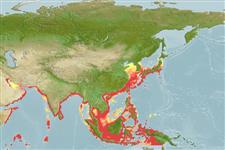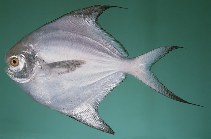Добавить Ваши наблюдения в Fish Watcher
| Native range | All suitable habitat | Point map | Year 2050 |

|
| This map was computer-generated and has not yet been reviewed. |
| Pampus argenteus AquaMaps Data sources: GBIF OBIS |
Загрузить свой Фото и Видео
Pictures | Stamps, coins, misc. | Изображение на GooglePampus argenteus
Picture by Randall, J.E.
Pictures | Stamps, coins, misc. | Изображение на GooglePampus argenteus
Picture by Randall, J.E.
Korea (South) country information
Common names:
Chaet-pyǒng-ǒ, Pyǒng-ǒ, Tǒk-dae
Occurrence: native
Salinity: marine
Abundance: | Ref:
Importance: | Ref:
Aquaculture: | Ref:
Regulations: | Ref:
Uses: no uses
Comments: Reported from the coastal water of Gadeok-do (Ref. 37629).
National Checklist:
Country Information: https://www.cia.gov/library/publications/resources/the-world-factbook/geos/ks.html
National Fisheries Authority:
Occurrences: Occurrences Point map
Main Ref: Kim, I.S., Y. Choi, C.L. Lee, Y.J. Lee, B.J. Kim and J.H. Kim, 2005
National Database:
Occurrence: native
Salinity: marine
Abundance: | Ref:
Importance: | Ref:
Aquaculture: | Ref:
Regulations: | Ref:
Uses: no uses
Comments: Reported from the coastal water of Gadeok-do (Ref. 37629).
National Checklist:
Country Information: https://www.cia.gov/library/publications/resources/the-world-factbook/geos/ks.html
National Fisheries Authority:
Occurrences: Occurrences Point map
Main Ref: Kim, I.S., Y. Choi, C.L. Lee, Y.J. Lee, B.J. Kim and J.H. Kim, 2005
National Database:
Common names from other countries
Классификация / Names народные названия | синонимы | Catalog of Fishes(род, виды) | ITIS | CoL | WoRMS | Cloffa
Issue
Pampus cinereus is considered a valid species according to Liu et al., 2013 (Ref. 95516) and P. liuorum Liu & Li, 2013 (Ref. 95101) is a junior synonym of Pampus cinereus according to Yin et al., 2019 (Ref. 123875).
Environment: milieu / climate zone / depth range / distribution range экология
морской донно-пелагический; мигрирует в океане (Ref. 51243); пределы глубины 5 - 110 m (Ref. 12260). Subtropical; 46°N - 10°S, 47°E - 142°E
распространение страны | регионы FAO | Ecosystems | места находок | Point map | интродукции | Faunafri
Indo-West Pacific: Persian Gulf to Indonesia, north to Hokkaido, Japan. Extralimital captures have been made from the Adriatic and off Hawaii. Not recorded from Australasia. Northeastern Atlantic: 3 reports of capture reported from this area (Ref. 86350).
Length at first maturity / Size / Вес / Возраст
Maturity: Lm 25.3, range 18 - ? cm
Max length : 60.0 cm SL самец/пол неопределен; (Ref. 9811); common length : 30.0 cm SL самец/пол неопределен; (Ref. 9811); наибольший возраст (опубликованны данные): 7 годы (Ref. 45538)
Max length : 60.0 cm SL самец/пол неопределен; (Ref. 9811); common length : 30.0 cm SL самец/пол неопределен; (Ref. 9811); наибольший возраст (опубликованны данные): 7 годы (Ref. 45538)
Краткое описание определительные ключи | морфология | морфометрия
колючие лучи спинного плавника (общее число) : 0; членистые (мягкие) лучи спинного плавника (общее число) : 37 - 43; позвонки: 34 - 37. Body firm, very deep, oval, and compressed. Operculum absent; gill opening reduced to a vertical slit on the side of the body; gill membrane broadly united to isthmus. Dorsal and anal fins preceded by a series of 5 to 10 blade-like spines with anterior and posterior points. Pelvic fins absent. Caudal fin deeply forked, the lower lobe longer than the upper. Color is gray above grading to silvery white towards the belly, with small black dots all over the body. Fins are faintly yellow; vertical fins with dark edges.
Inshore species, usually in schools over muddy bottoms, associated with fish species like Nemipterus and Leiognathus. Adults feed on ctenophores, salps, medusae, and other zooplankton groups. Western populations spawn from late winter through the summer with peaks from April to June. Sold fresh in local markets or shipped frozen to urban centers. Used in Chinese medicine (Ref. 12166).
Life cycle and mating behavior половая зрелость | размножение | нерест | икра | Fecundity | личинки
Основная ссылка
Upload your references | ссылки | координатор | соавторы
Haedrich, R.L., 1984. Stromateidae. In W. Fischer and G. Bianchi (eds.) FAO species identification sheets for fishery purposes. Western Indian Ocean (Fishing Area 51). Vol. 4. FAO, Rome. pag. var. (Ref. 3517)
Угроза для людей
Harmless
Использование человеком
рыболовство: важный объект промысла
FAO(рыболовство: production; publication : search) | FishSource | Sea Around Us
дополнительная информация
Population dynamics
Growth parameters
Max. ages / sizes
Length-weight rel.
Length-length rel.
Размерный состав
Mass conversion
пополнение
численность
Growth parameters
Max. ages / sizes
Length-weight rel.
Length-length rel.
Размерный состав
Mass conversion
пополнение
численность
Life cycle
размножение
половая зрелость
Fecundity
нерест
Spawning aggregations
икра
Развитие икры
личинки
динамика численности личинок
размножение
половая зрелость
Fecundity
нерест
Spawning aggregations
икра
Развитие икры
личинки
динамика численности личинок
Anatomy
жаберная область
Brain
Otolith
жаберная область
Brain
Otolith
Physiology
Body composition
Nutrients
Oxygen consumption
Swimming type
Swimming speed
Visual pigments
Fish sound
Diseases & Parasites
Toxicity (LC50s)
Body composition
Nutrients
Oxygen consumption
Swimming type
Swimming speed
Visual pigments
Fish sound
Diseases & Parasites
Toxicity (LC50s)
Genetics
генетика
Heterozygosity
наследуемость
генетика
Heterozygosity
наследуемость
Human related
Aquaculture systems
особенности рыбоводства
степень растяжения
Ciguatera cases
Stamps, coins, misc.
Aquaculture systems
особенности рыбоводства
степень растяжения
Ciguatera cases
Stamps, coins, misc.
инструменты
E-book | полевой определитель | определительные ключи | Длина-Частота | онтогенез | карта точек | Classification Tree
| Catch-MSY |
Специальные отчеты
Проверить содержание в аквариумах | Проверить опубликованные видовые данные | Проверить опубликованные данные по аквакультуре
Скачать в формате XML
ресурсы в Интернет
Aquatic Commons | BHL | Cloffa | BOLDSystems | Websites from users | Проверить FishWatcher | CISTI | Catalog of Fishes(род, виды) | DiscoverLife | ECOTOX | Faunafri | Fishtrace | GenBank(Геном, Нуклеотид) | GloBI | GOBASE | | Google Books | Google Scholar | Google | IGFA World Record | MitoFish | национальные базы данных | Otolith Atlas of Taiwan Fishes | PubMed | Reef Life Survey | Определение с помощью Regulatory Fish Encyclopedia | Scirus | SeaLifeBase | Tree of Life | Wikipedia(Вперёд, поиск) | World Records Freshwater Fishing | Zoological Record
Estimates based on models
Preferred temperature (Ref. 115969): 21.9 - 29.1, mean 28.1 (based on 1636 cells).
Phylogenetic diversity index (Ref. 82804): PD50 = 0.5313 [Uniqueness, from 0.5 = low to 2.0 = high].
Bayesian length-weight: a=0.01820 (0.01405 - 0.02357), b=3.02 (2.95 - 3.09), in cm Total Length, based on LWR estimates for this species (Ref. 93245).
Trophic level (Ref. 69278): 3.3 ±0.1 se; based on diet studies.
устойчивость к внешним воздействиям (Ref. 120179): средний (среднего размера), минимальное время удвоения популяции 1.4-4.4 года (K=0.24-0.26; tmax=7; Fec=5,470).
Prior r = 0.57, 95% CL = 0.37 - 0.85, Based on 9 data-limited stock assessments.
Fishing Vulnerability (Ref. 59153): Low to moderate vulnerability (31 of 100).
Climate Vulnerability (Ref. 125649): Moderate to high vulnerability (48 of 100).




